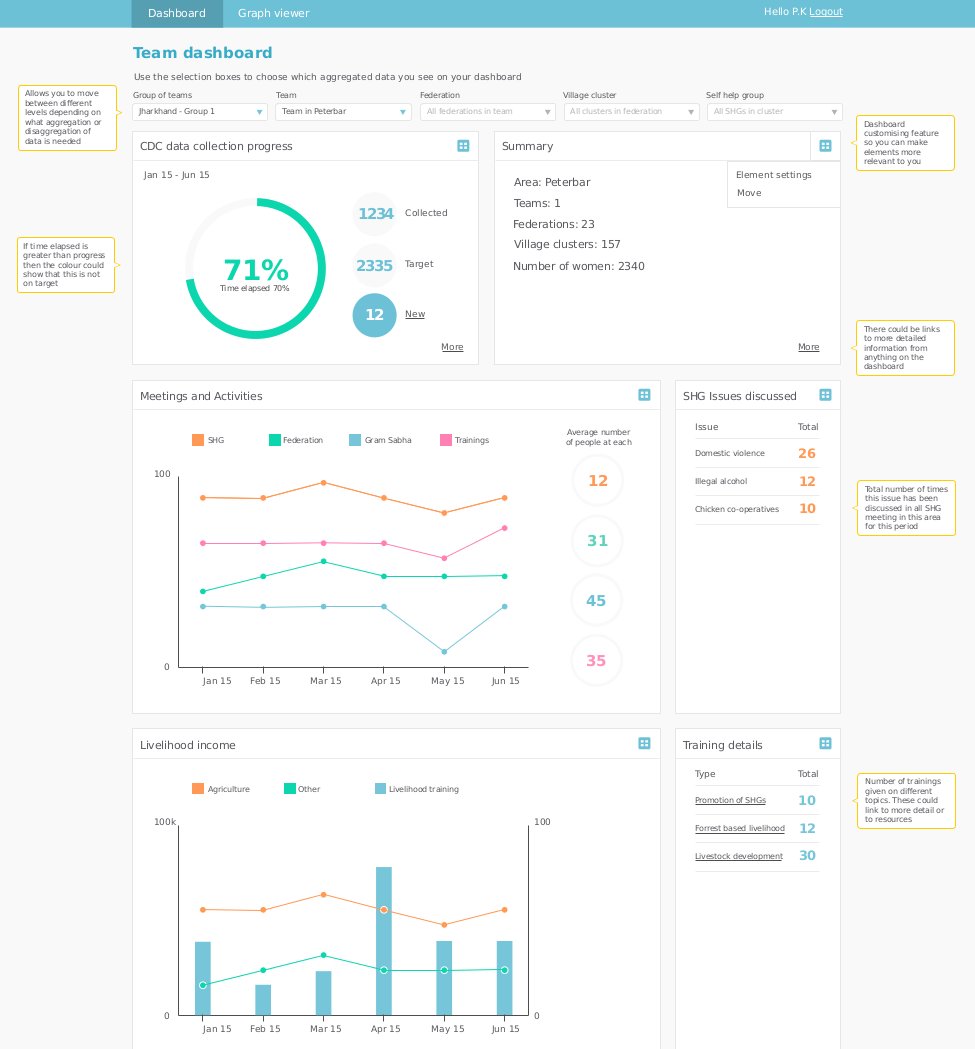A participatory discovery process in India
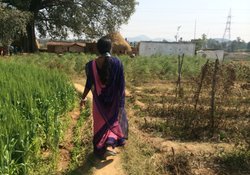
Martin Belcher, Marko Samastur and I travelled to India in February to work with Pradan who work in the poorest districts of India, transforming lives and choices of poor communities.
Pradan really understands how to engage and include their beneficiaries in the work they do, which meant this was a wonderful opportunity for us to work in a truly participatory way. On the trip we were engaging stakeholders at every level of the organisation from the Corporate Circle in Delhi to the Self Help Group members from rural tribal villages.

The organisation have recently been implementing a Monitoring, Evaluation and Learning (MEL) data collection process using CommCare and Samsung tablets. 1000 women from the villages they work with have been employed and trained as data collectors. They have just started collecting data about the work Pradan is doing.
In the past a paper based process was used to collect this data and Pradan created some basic reports from these. The team members would have to process the raw data to help with their decision making. The new method will provide more detailed information, which will be available more readily. Our task was to find out how this MEL data can be used to help them make decisions and achieve their goals, making recommendations for an MEL information system.
The discovery process
We spent the time in India facilitating a number of workshops to understand the needs of different potential users of the data. We wanted to find out what information people need, what this will help them achieve and what format would be most useful to them. Here is what we got up to over the 8 days.
Day 1
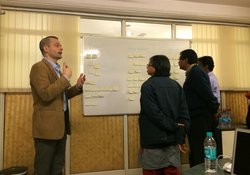 We started the trip in Delhi, meeting with the corporate circle. This was a chance for them to share their hopes for the project and for us to map out the potential stakeholders/users and begin to understand how Pradan works.
We started the trip in Delhi, meeting with the corporate circle. This was a chance for them to share their hopes for the project and for us to map out the potential stakeholders/users and begin to understand how Pradan works.
Day 2
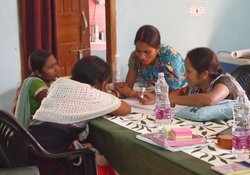 After arriving in Ranchi we traveled to Peterbar meet the Pradan team there and a group of Community Data Collectors (CDCs). We helped them create personas for their roles to help us understand their background, technical knowledge, tasks, concerns, decisions and Information needs.
After arriving in Ranchi we traveled to Peterbar meet the Pradan team there and a group of Community Data Collectors (CDCs). We helped them create personas for their roles to help us understand their background, technical knowledge, tasks, concerns, decisions and Information needs.
Day 3
 On this day we visited a village, they showed us around explaining how they have been developing different crops and rearing chickens. This gave us a great insight into how Pradan’s work is helping families in these villages and hear from the beneficiaries, learning what challenges they face and what types of information they are interested in. We also learnt about their methods for sharing and learning information. In the afternoon we met a Federation, a group of elected representative from different villages who come together to make decision and receive training from Pradan. We worked with them to write user stories explaining what kind of information they need.
On this day we visited a village, they showed us around explaining how they have been developing different crops and rearing chickens. This gave us a great insight into how Pradan’s work is helping families in these villages and hear from the beneficiaries, learning what challenges they face and what types of information they are interested in. We also learnt about their methods for sharing and learning information. In the afternoon we met a Federation, a group of elected representative from different villages who come together to make decision and receive training from Pradan. We worked with them to write user stories explaining what kind of information they need.
Day 4
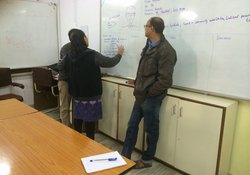 We met a group of Pradan Integrators in Ranchi. They are in charge of overseeing a particular area and assisting a number of teams. They created a persona and shared their needs with us.
We met a group of Pradan Integrators in Ranchi. They are in charge of overseeing a particular area and assisting a number of teams. They created a persona and shared their needs with us.
Day 5
 Back in Delhi we met the MIS team, learning what systems Pradan use already. They demoed the different functions to us which helped us understand what information people already have access to and how they use it.
Back in Delhi we met the MIS team, learning what systems Pradan use already. They demoed the different functions to us which helped us understand what information people already have access to and how they use it.
Day 6
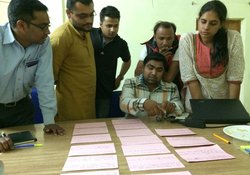 We arrived in Itarsi and travelled to Betul. Here we got to visit a different area and meet another self help group in their village. They shared their needs with us by drawing a diagram showing the different places they can get information and assistance from. Later we travelled to the Pradan office in Betul and worked with another group of CDCs and the Pradan team. We developed the personas that the other group had made and asked them to write user stories to explain their needs.
We arrived in Itarsi and travelled to Betul. Here we got to visit a different area and meet another self help group in their village. They shared their needs with us by drawing a diagram showing the different places they can get information and assistance from. Later we travelled to the Pradan office in Betul and worked with another group of CDCs and the Pradan team. We developed the personas that the other group had made and asked them to write user stories to explain their needs.
Day 7
 We spent this day with another Federation. They created personas for three key roles, Federation Member, Self Help Group Member and Community Service Provider.
We spent this day with another Federation. They created personas for three key roles, Federation Member, Self Help Group Member and Community Service Provider.
Day 8
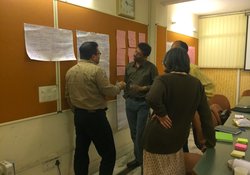 In Delhi, we spent the last day with the Corporate Circle, we shared the work that the other groups had done and they contributed their ideas. We also had a chance to meet with the Communication team who explained what information would help them Promote Pradan to attract donors and help with recruitment.
In Delhi, we spent the last day with the Corporate Circle, we shared the work that the other groups had done and they contributed their ideas. We also had a chance to meet with the Communication team who explained what information would help them Promote Pradan to attract donors and help with recruitment.
Workshop tools
The workshops were focused around two key things that we asked the groups to create:
A user persona
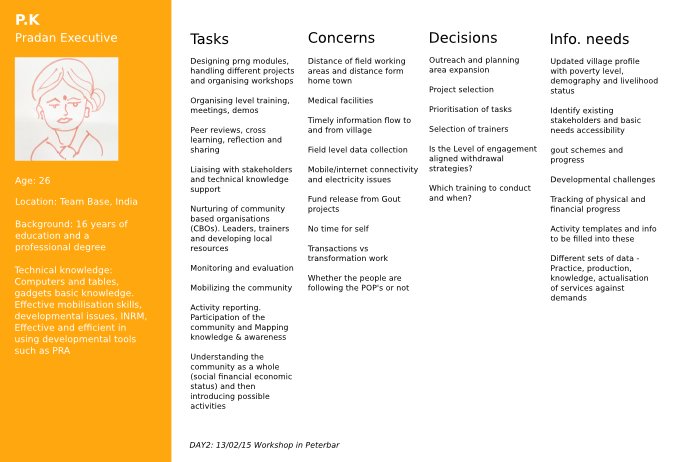
We asked people to work in groups and create a persona for their role within Pradan. This is a made up profile which helps us understand what a typical person in this role might be like. We want to know:
- What is their life like?
- What technology do they use?
- What tasks do they do ask part of their role?
- What concerns do they have?
- What decisions do they need to make?
- What are their information needs?
This is a great way to get people talking, agreeing on the answers to these questions in a group and writing them down to share with us. After spending about an hour creating these we asked the groups to present back what they had written to the group.
A user story
After creating the personas we moved onto the user stories, asking people to write down what their needs are in a particular format.
As a ….. I want to …… so that I can ……
This give us a clear statement directly from the user about what they want and why. The ‘So that I can’ part of the user story is very important as it tells us what people are trying to do, helping us know how to design the best solution to help them achieve their aim.
The report
We are able to get most of the resources translated and typed up after each workshop. When we returned home we started processing the information and pulling it together to create some preliminary designs and recommendations based on what the stakeholders we met and shared. Pradan will be taking this report and using it to inform how to go about building an MEL information system to help their work. Here is one of the layouts ideas we suggested for a dashboard.
